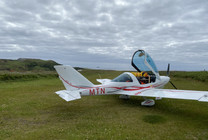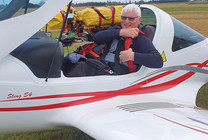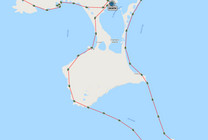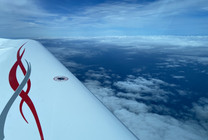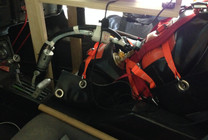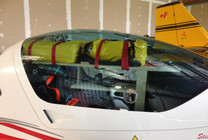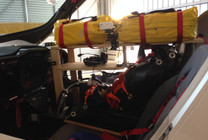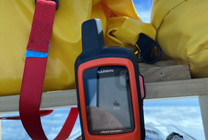Trip to the Chatham Islands in TL-2000 Sting
To the Chathams in a modern microlight. Glenn Martin has prepared for you a very interesting article about his trip to the Chatham Islands.
The why:
I am, and always will be, a Recreational Pilot, I started too late in life to be anything else, as a forever low hour Pilot (currently 1450hr) I decided to continue my Aviation education once achieving my licence by doing additional things. These have included a Mountain flying course, seminars, extra ratings and deciding to try and fly to every Airfield in the AIP. Thus far I have flown to 122 AIP fields, and many ag strips etc.
The Chathams lie 876 km East of my home base of Rangiora…just take off on Zero Seven and extend upwind a bit… People have been flying there for over 100 years and there was a group of second generation Microlights that went there many years ago, so my flight was not unique, just unusual.
The plane:
MTN is a modern third generation “Ultralight” from the Czech Republic. There are several in NZ, MTN is the only one registered as an LSA. This enables it to be used for Part 91 training, but makes little practical difference. An aircraft designed on CAD and tested before being built with CFD in the 2000’s has all the vices designed out before committing to Carbon fibre. MTN is very easy to fly and very forgiving. The Rotax 912IS engine is of course very good too, as my LAME says “The difference is that Rotaxes ACTUALLY get to TBO”. In the USA where they have been running Rotax engines “on condition” for many years, 5000 hr between overhauls is not uncommon.
Like all Aircraft there are “Options” when you buy it, a “six pack” or “Glass ? MTN has a Garmin glass cockpit/three axis Autopilot/Constant speed prop/ ELT/Parachute and coffee maker…well not the coffee maker.
Additions for long flight include a “ferry tank” for another 68L making 175L usable (12+ hr and 2300 km at 14l/hr). Life raft and dry suit, Spidertracks so people can stalk me. Garmin InReach and Satphone for backup Comms. Navigation primarily on the Garmin G3X and backup Ipad with AvPlan.
A Modern Microlight/LSA indeed this is Not a compass watch and sextant type of flying, although anyone whom has done that has my enduring respect!
We live on a Continent:
I have flown from Cape Reinga to Stewart Island and many places in between, I never knew this was a Continent! This is legally all in the NZZC (Continental NZ) once you go across a line about 50nm off shore you are in the NZZO (Oceanic). The rules for flying “Oceanic” are a little different and you communicate with “Auckland Oceanic”. Tim Halpin and his team were very helpful in not only explaining the rules but taking a “duty of care” with my prep and flights.
Practice:
To fly as fast as possible efficiently of course you need to go high. The rules in NZ limit you to 10,000 ft without extra oxygen (12,500 in USA). There I found the “nicest” speed was 90kt IAS and therefore 109 TAS and 14L/hr. Practice was two 5+ hour flights over the South Island at that height and tried out all the systems, including measuring my O2 saturation and doing long division exercises to see if the brain was still working. Also thanks to “Travel Johns” the other obvious problem was tested.
Air Chathams:
Local knowledge is always the best and Matt Emeny and the team at Air Chathams kindly supplied advice, onsite Wx reports, in Air updates and coffee on arrival.
On the Day there were low clouds at Rangiora (1000ft BKN) Frank flew out to the coast and reported some holes further out ATC reported cloud tops at 2000ft. Air Chats gave a good report for arrival. I had some issues with filing a VFR flight plan via an IFR process but we do these things to learn ! Three friends escorted me out to the coast and a few miles further out there were gaps large enough to easily climb through. As reported the cloud tops were 2000 ft. Slow climb to cruising altitude, some VHF reports then handed off to Oceanic contacted via the Satphone. I like flying and almost never use the Autopilot but this seemed like the right time. Air chats updated me on the Wx at NZCI on 123.45 the universal over ocean VHF frequency.
Like Limburg I have a paper backup with waypoints and next magnetic heading each 50 nm this gives an ultimate backup if the fancy stuff fails. In addition I recorded 29 other parameters like oil pressure fuel, fuel burn etc …something to do. With the position reporting the paperlog, and looking at the view the flight went very well. Going EAST I had a 20 kt tail wind so groundspeed (seaspeed ?) was over 120kt. One funny thing the latitude increases from 174 deg up to 180 then as you pass the “anti meridian” it decreases again, on it you are directly opposite Greenwich London the prime meridian !.
NZCI is a great runway 1.3 km long and sealed so only need a little of that landed after 4.6 hr and 65L burnt.
Tourist :
Pilot tourist of course I went for a drive to see the Sunderland in the NE of the Island. The full story of how it ended up here is ..
https://www.airforcemuseum.co.nz/blog/sunderland-nz4111-and-the-chatham-islands-incident/
I went to see the nearby seal colony, had a wetlands walk and a beach walk, all great fun and the Chathams are a very different Island experience. After a great buffet where I went back for thirds on the fish dishes an early night.
I have a plane on an Island so went for a Tiki tour circumnavigating the rest of the bit I had not seen. Over to PITT Island and a runway more like I know. Then back around the rest. Another great meal at Admiral Garden then early night to be ready for the home trip.
Home again:
Air Chathams is very busy and I tried to time my flights to keep out of their hair, so I timed my departure accordingly. This time no tailwind and I fluffed my Chathams time to NZT conversion to UTC with Oceanic but they were forgiving! Same profile Oceanic to LRG VHF to CHCH Approach to Rangiora frequency. Again some friends to meet me back at the Coast total time 5.1 hr (75L).
In the end what you want, I believe, with Oceanic flight is a lot of prep and no dramas on the actual flight. I learnt a lot and made some minor mistakes but will do better next time.
We are all very lucky to have these modern efficient and reliable aircraft available do not be afraid to use them!
文件下载
- kiwiflyer-chathams.pdf (PDF 12.03 MB)



